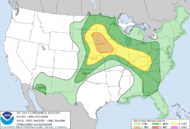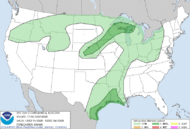
Me hiking at Glacier National Park
Contact
You can find my email address at the very bottom of this page.
Bio
I'm James Hammett, a software engineer and storm chaser based in Denver, Colorado. I began forecasting and traveling locally to observe storms and tornadoes in 1999. In 2004 I purchased my first video camera and captured a tornado on video later the same day. I was hooked and immediately expanded my chasing range across the Great Plains. I've since been out every spring in search of the most incredible severe weather to witness, record, and report. I've chased from Montana to Texas and Colorado to Iowa and may stay on the chase for a few days at a time as the weather and life allows.
I've taken a few college-level courses in weather forecasting both formally and informally. But much of what I know about meteorology and chasing I've learned from meteorologists, other storm chasers, and years of trial and error out in the field. As a trained weather spotter I report severe weather I encounter to the National Weather Service.
During the off-season I spend time working on projects in support of storm chasing like video and photo editing, website updates, and chase vehicle upgrades. I also engineer software and electronics that will help me make better forecasts, make better chase execution decisions, and get better photos and videos. Read more about my chase vehicle and the technology I use»
Why chase tornadoes?
There isn't a single answer to this question, as different storm chasers have long been motivated by different aspects of chasing storms. Back in 1982 legendary storm chaser and Storm Track magazine founder David Hoadley weighed in and it's worth a read. A lot has since changed about storm chasing in the years since but the core experience described here remains the same.
Why chase tornadoes? This is a question frequently asked of chasers. It is not something that can be answered while waiting for the elevator or in small conversation at a cocktail party. It touches many levels and requires a measured response to fully answer. If my experience is characteristic of most chasers, there are at least five levels at which we relate to the big storm.
First is the sheer, raw experience of confronting an elemental force of nature, uncontrolled and unpredictable, which is at once awesome, magnificent, dangerous and picturesque. Few life experiences can compare with the anticipation of a chaser while standing in the path of a big storm, in the gusty inflow of warm, moist gulf wind, sweeping up into a lowering, darkening cloud base, grumbling with thunder as a great engine begins to turn.
Read more at Stormtrack: WHY CHASE TORNADOES?
Further reading about storm chasing and meteorology
- Doswell, Charles A., III. "Storm Chasing with Safety, Courtesy, and Responsibility."
- Edwards, Roger. "The Online Tornado FAQ."
- Edwards, Roger and Vasquez, Tim. "The Online Storm Chasing FAQ."
- Haby, Jeff. "Haby's Weather Forecasting Hints."
- MetEd. The University Corporation for Atmospheric Research, www.meted.ucar.edu.
- Weather Glossary for Storm Spotters. National Weather Service, www.weather.gov/oun/spotterglossary.
|




 Fediverse (Mastodon)
Fediverse (Mastodon)
 Bluesky
Bluesky


